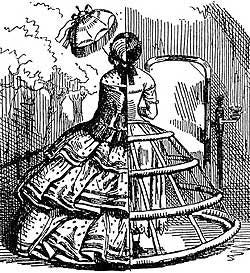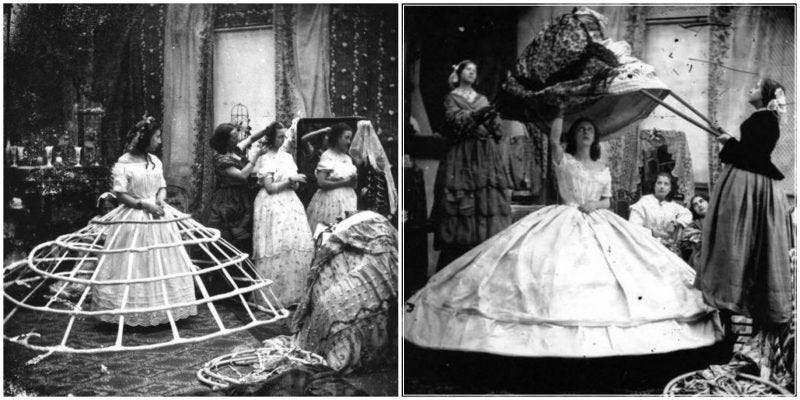The Strange and Surprising History of the Hoop Skirt and Bustle Dresses in America
Why in the world would women think this was a good fashion choice?



Issue #299 Friday Funday April 14, 2023
In the mid-19th century, the hoop skirt was the height of fashion in America. Women of all classes and ages wore these flowing, bell-shaped dresses. But by the early 20th century, the hoop skirt had fallen out of favor, deemed too impractical and old-fashioned.
The 1800s crinoline, also called a hoop skirt or extension skirt, was inspired by the open cage or frame style of the 16th- and 17th-century farthingale and the 18th-century pannier.
Just as the size of your wig helped determine your status in the 18th century (hence the nickname “big wig” ascribed to rich and powerful people), the size of your hoop skirt often indicated that you were wealthy enough to afford not only the amount of fabric needed but also to have the number of servants (or handmaidens) to help you get dressed every day.
The hoop skirt, also known as a crinoline, first became popular in the 1850s. At this time, women’s fashion was focused on creating a voluminous silhouette, with wide skirts that tapered at the waist. To achieve this shape, women wore layers of petticoats made of heavy fabrics like wool and cotton. But the hoop skirt offered a revolutionary solution to this problem.
By using a series of hoops made of steel or whalebone, the skirt could be lifted away from the legs, creating a bell shape that was both stylish and practical. The hoops also made the skirt lighter and easier to move in, allowing women to participate in activities like dancing and horseback riding. The hoop skirt quickly became a symbol of status and style, with women of all classes clamoring to own one.
Please make sure to view and act on the important information at the end of this article to help support “We Are Speaking.” Thank you!
At its peak in size, the crinoline reached a diameter of up to 180 centimeters, almost six feet.
The trend was so popular that even young girls were dressed in miniature versions of the hoop skirt. Fashion magazines of the time featured extensive articles and illustrations on the different styles and designs of hoop skirts, showing just how influential they had become in American culture.
However, there were some drawbacks to wearing a hoop skirt. The hoops made the skirt very wide, leading to issues with mobility and maneuverability. Women had to learn how to navigate through doorways and narrow spaces without knocking over objects or getting tangled up in their skirts. Additionally, they were quite difficult to move around in, they were quite difficult to keep clean, and they could be quite dangerous if they caught on fire.
During the middle of 19th-century England, over 3000 women lost their lives in fire-related crinoline accidents. One accident involved the death of a 14-year-old girl - the servant of a wealthy family. Her dress had caught on fire as she was attempting to reach several spoons above the fireplace. The girl died after suffering agony for hours on end, resulting from her serious burns.
However, the dangers of crinolines were not limited to fire. Women would accidentally step on the dress or worse - it would get caught underneath the wheels of carriages. Wind could also fill up a crinoline with air and toss a lady about. All of these problems eventually led to the crinoline dropping out of fashion trends.
There were also concerns about the hoop skirt’s effect on health. Some doctors believed that the pressure of the hoops on a woman’s waist could lead to digestive problems and even damage to internal organs. Others worried that the weight of the skirt could cause back problems or worsen existing conditions like scoliosis.
Despite these concerns, the hoop skirt remained in fashion throughout the 1860s and 1870s. But by the 1880s, a new style of dress had emerged that favored a slimmer silhouette. The bustle, a padded device that added volume to the back of a skirt, replaced the hoop skirt as the must-have fashion item.
The hoop skirt’s decline continued into the 20th century, with many women abandoning it altogether in favor of more streamlined and practical styles by the time of the “roaring 20s.”
You can always leave any questions in the comments or email us.
This article is free to access for 7 days after publication. Please consider becoming a paid subscriber for $5/month or less to access all of the articles and other benefits.
What else do Keith and Pam do?
Where else can you find us?
Click the link below to find out everything you need to know and review everything we offer for independent writers and creative and solo professionals.



